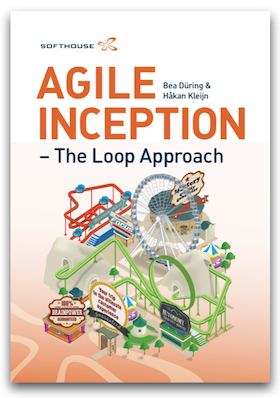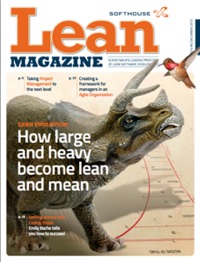In little more than a decade, Agile, Lean, Scrum and other modern methods have created amazing opportunities for the software industry to increase productivity, improve quality and, not in the least adapt to a changing environment. But what about the business environment to which the methodologies apply – have they kept up with these project management methodology developments?
Bea Düring, PMI Certified PM and Agile Coach at Softhouse, has almost 15 years of experience in project management consulting and examines this with a critical eye. She has seen many companies struggle with the same problems when adopting Agile methodology. Getting the development team started is just the first step. An equally important challenge is providing teams and this methodology a natural place in the business environment. This is where she sees a problem: “Other industries and fields are developing at lightning speed – why is project management so sluggish? Or to put a more fine a point on it: why have we let so many projects fail for so long?”
Project-based thinking

Bea Düring believes that project management’s heyday ended in the 1960s and that innovation has been at a standstill since. Many of the tools in use today such as Gantt charts, work breakdown structure and PERT originated in the industrial setting of the early 1900s. They work well in industries with a slow pace of change and sustainable long-term plans. Technology develops rapidly in the software industry, however, and the market goes through unexpected twists and turns. It requires a different way of thinking, and therefore new types of tools. Management in companies implementing Agile methods need to understand what a ‘project’ is. A good starting definition is to describe it as ‘a temporary organization to interact with a company’s permanent organization.’ ‘There are many companies that have not yet been able to grasp what project-based thinking and project management are all about. Management and support departments must learn to regard projects as a type of service delivery environment.’
The engine of the organization
There is often talk of the Agile delivery engine – that is, Scrum team activity hums steadily along delivering fresh, functional code ready for shipping. This metaphor is useful in explaining a project manager’s role in an Agile organization. The Project Leader is the mechanic whose job it is to install the Agile delivery engine into the organization’s vehicle and ensure that it remains finely tuned. The engine’s primary task is to reach the organization’s delivery targets. Its operations also need to be synchronized with the other components such as customer support, sales, external suppliers, partner, etc. ‘In this context, it is time to define a new type of project manager – the Agile Project Manager. An Agile project man- ager understands how the Agile delivery engine works – that the concept is based on self-organization and undisturbed activity. In addition, he or she has the ability to manage business needs and goals, requirements, organizational models, contracts and overarching as well as ‘roll-ing’ planning methods,’ says Bea Düring.
The complexity level dictates
When is a ‘regular’ project manager enough and when is an Agile project manager necessary? It depends on the project’s complexity. According to the Cynefin model, a project considered Complex demands an Agile project manager. ‘In my experience of coaching Agile transitions, there is a need for an Agile project manager when the project and delivery engine is exposed to complexity factors – as in, for example, when several teams collaborate on a release from a number of international locations.’ Requirements themselves may also lead to complexity such as when teams are faced with regulatory requirements or the need for extremely rapid alteration cycles. Other complexity factors are outsourcing and procurement – that is, the purchase of various services from multiple providers – or when a company starts too many projects at the same time resulting in staff having so much to do that nothing gets done. ‘Several of these complexity factors exist in many of the companies we work with, and they have a cumulative effect. An Agile project leader can achieve great things in such messy conditions by designing a comprehensive project environment providing oversight and structure,’ says Bea Düring.
The Agile Project Manager
Where are these Agile Project Managers, then? The clichéd response is ‘nowhere and everywhere’. The international body PMI launched a type of formal certification in 2011, but specialized Agile project manager candidates can be found almost anywhere.‘It is up to the management implementing an Agile transformation
to work with existing project managers. To what extent is their customer knowledge and experience applicable to this new para-digm? How do we create a system of ‘do, learn, adapt’ so that we can teach our- selves? How big is the need for external skill development?’ It is important that the organization’s Agile project managers be provided with diagnostic tools such as the Cynefin Model for their projects. ‘From there, they can design the most suitable project life cycle and build in feedback loops for continuous improvement of the process. Of course, it is import- and to master the conventional toolbox and understand how to facilitate an Agile project environment. Both skills are necessary’, said Bea. ‘The decision anxiety that often per-meates Swedish company culture must be eliminated.’
A chance for Sweden to take the lead
There is great opportunity for Sweden to take the lead in introducing Agile methodology. Companies could strengthen their competitiveness. First, Agile reduces development costs since continuous improvement is built into the very concept. Second, Agile creates an environment of innovation. Bea Düring thinks Sweden has particularly good prospects for Agile methodology success: ‘We are used to working in flat, network-based collaboration in Sweden. We are not so concerned with work-related hierarchy.’ Agile is largely based on self-organization and cross-functional working groups. The compatibility is obvious. She sees a major obstacle to overcome, however: the decision anxiety that often permeates Swedish company culture. ‘Many managers simply do not dare say ‘let’s do it’. Instead of starting a process by testing it out, gaining experience and learning, they kick decisions down the road. One can see this behaviour amongst many teams. A symptom of this inability to make decisions is Swedish business culture itself – a forum of meeting after meeting which everyone is forced to attend. It causes a lot of frustration not in the least amongst guests from the foreign companies we cooperate with. We need to rethink this.’



